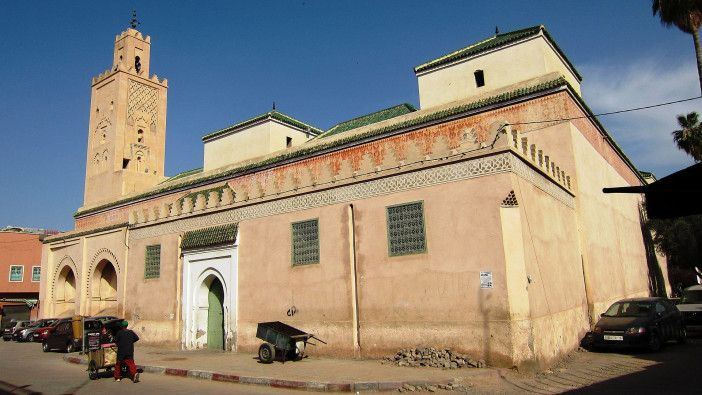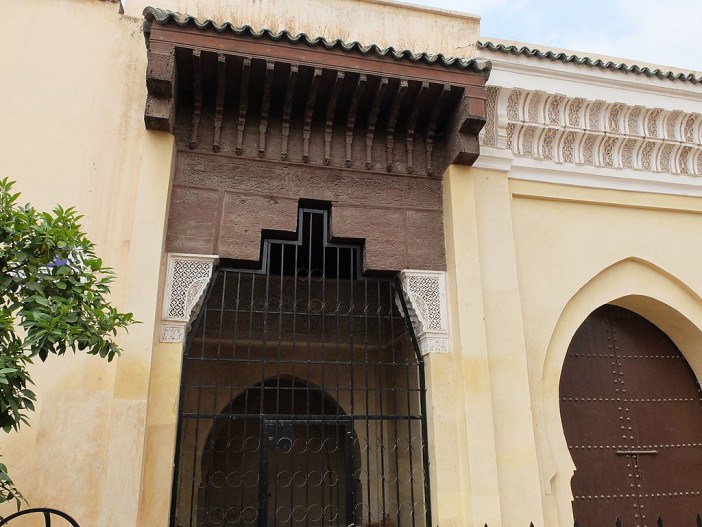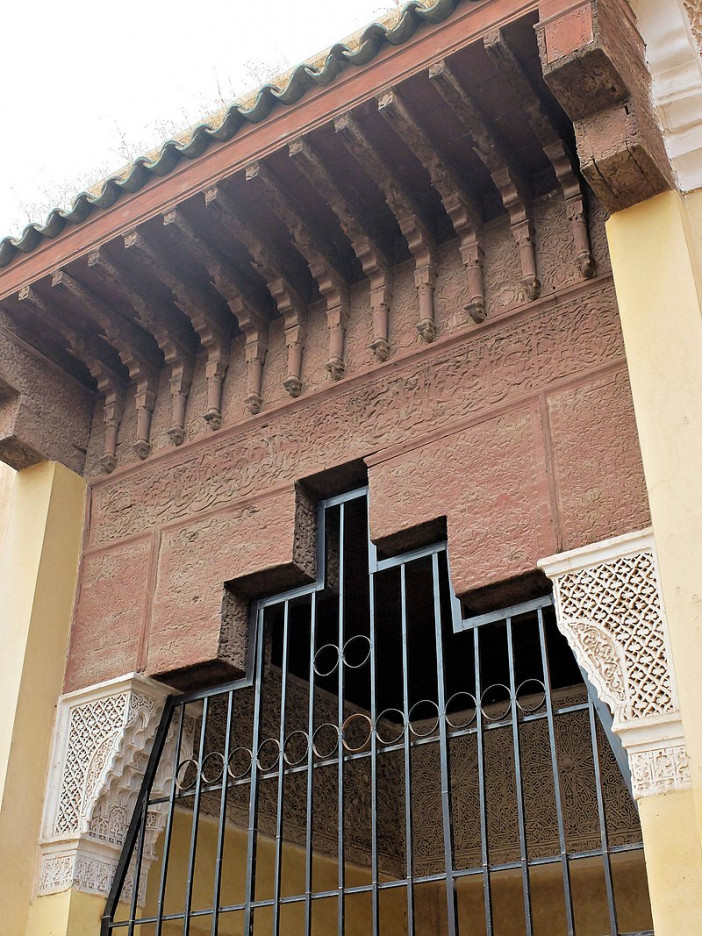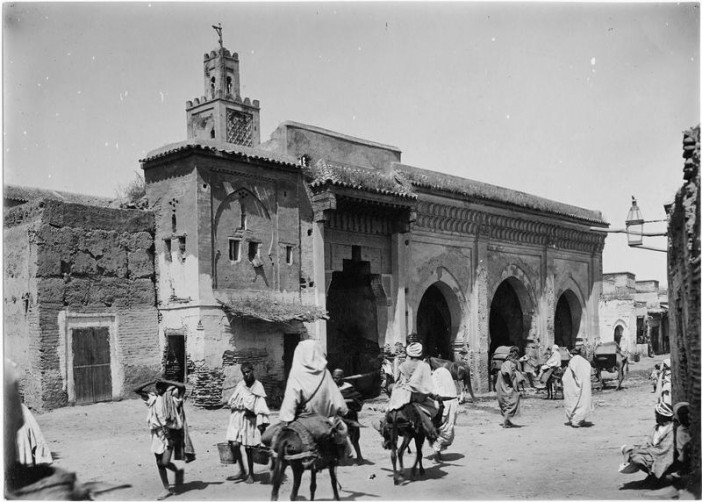Bab Doukkala Mosque
History
During the Saadian Dynasty, Lalla Mas'uda bint Ahmad, the mother of Sultan Ahmad al-Mansur and a daughter of Muhammad al-Sheikh (the Saadian Dynasty's founder), ordered it.Under Moulay Abdallah al-rule, Ghalib's construction on the mosque commenced in 1557–1558 CE (965 AH) and most likely ended in 1570–1571 CE (979 AH). Jami' al-Hurra, the mosque's alternate name, may have originated from Lalla Ma'suda's position as a strong and independent woman ("Mosque of Freedom").
A Jewish mellah was established in 1557–1558 CE after the sultan ordered that the city's Jewish community move to a neighborhood nearer the Kasbah (the royal citadel). This mellah lasted well into the contemporary era. The new mellah's construction was most likely completed between 1562 and 1563. A significant area of the city had been made available for renovation while the historic Jewish neighborhoods had been emptied. The Mouassine Mosque and the Bab Doukkala Mosque, which were both constructed at the same time, seem to have been a part of a broader scheme to create new "model" communities nearby.
It was designed to be a component of a cohesive religious and civic complex that also included a madrasa, library, hammam (public bathhouse) with latrines, an ablutions house or mida'a (Arabic: ), and a public fountain for supplying water to the community. Though many mosques constructed during the Marinid era had adjacent facilities, this type of magnificent architectural complex was unheard of in Morocco and may have been influenced by the custom of constructing such complexes in Mamluk Egypt and the Ottoman Empire.
After the mosque's completion, the minaret appears to have been added. According to its architectural style, Xavier Salmon hypothesizes that it was likely constructed at the start of the 17th century, at the same time as the Abu Faris Abdallah-built tower of the Zawiya of Sidi Bel Abbes. The three arches on the mosque's northeastern facade, which are close to the base of the minaret, likely originate from this period and were used to strengthen the surrounding walls so that the tower could stand.
The mosque, the mida'a, the fountain, and the hammam of this complex were likely all built at the same time during the original construction, while the minaret, the small adjacent madrasa (no longer preserved), and the hammam were likely built at a later date.
While the minaret, the small adjacent madrasa (which is no longer preserved), and the msid (Qur'anic school for children), which was formerly attached to the mida'a, were of later construction, historian Gaston Deverdun asserted that the mosque, the mida'a, the fountain, and the hammam of this complex were likely all built at the same time during the original construction (possibly later in the Saadian period).
Urban and Architectural
The mosque
The Mouassine Mosque, which was constructed shortly after the mosque, has a very similar shape and design. Additionally, it keeps many of the architectural features of the Kutubiyya Mosque and the Tinmal Mosque, two earlier Almohad mosques. Although slightly smaller than the Mouassine Mosque, the Bab Doukkala Mosque's architecture is in some ways more complex and exquisitely ornamented. A hypostyle prayer hall makes up the mosque's smaller southern section, while its somewhat larger northern section is made up of a nearly square internal courtyard (a sahn) that is enclosed on all sides by a roofed gallery of arches.
A fountain sits in the middle of the courtyard, which is 29 by 30 meters. The mosque's northeastern corner is where the minaret is situated. Blind lambrequin arches and darj-wa-ktaf motifs are used to embellish its façades.
With the center aisle being slightly bigger than the rest, the prayer hall is divided into seven aisles or naves by rows of horseshoe arches running perpendicular with the southeast wall (the qibla wall). In addition to being highlighted at either end by a decorative cupola above, the mosque's central aisle is in line with its mihrab, a niche in the southeast wall that represents the direction of prayer (qibla). Directly in front of the mihrab, the cupola at the southeasterly end features a classic square design with muqarnas. Four muqarnas squinches help the cupola at the aisle's northwest end, where it faces the courtyard, transition from its octagonal shape to the square space below. The dome is likewise filled with muqarnas compositions.
According to an inscription on the cupola, the more ornate structure may be the result of renovation work completed in 1852-1853 CE (1269 AH) by Muhammad as-Sheikh al-M'amun (the future Muhammad IV) during Moulay Abd ar-rule. Rahman's Additionally, a third aisle forms a "T-plan" with the mosque's central aisle by running parallel to and perpendicular to the mosque's southeast wall. A sequence of transverse arches with pointed lambrequin profiles that run perpendicular to the other arches of the mosque serve to distinguish this transverse aisle from the rest of the building. Two lambrequin arches on either side of the mihrab serve as additional highlights and continue the pattern of arches down the mosque's main central aisle.
As a result, the three slightly more complex lambrequin arches that encircle the mihrab are similarly embellished with muqarnas inside of their intrados. A square-based muqarnas cupola is located at each end of the transverse aisle, near the mosque's southwest and southeast corners, respectively. Last but not least, bands of stucco carved with rather straightforward geometric decoration form semi-rectangular frames on the wall surfaces surrounding each arch to embellish the arches in the rest of the prayer hall.
The mihrab is decorated with the customary arabesque and geometric carvings on the surface of the wall around its arched doorway, as well as an inscription in Kufic that runs in a square frame around the arch. A tiny, octagonal muqarnas cupola is placed over the alcove inside the mihrab. While the decoration of the mihrab in this and other Saadian mosques is very similar to that of the earlier Almohad mosques in Marrakesh, Xavier Salmon observes that the decoration is less varied in its details and more repetitive, while also increasing the variety of bands or friezes of carved motifs.
The bayt al-'itikaf (Arabic: ), which served as a place for spiritual retreat, is located at the southwest corner of the mosque, extending from the transverse aisle in front of the qibla wall. It consists of a tiny square chamber with a double-arched window that looks back onto the mosque's prayer hall and is reached via a little staircase. The window's column is built of marble and has a capital with muqarnas carvings, and the arches have simple stucco ornamentation. This characteristic is also present at the Mouassine Mosque, however its bayt al-'itikaf has significantly more elaborate ornamentation.
Description
References
Salmon, Xavier (2016). Marrakech: Splendeurs saadiennes: 1550-1650. Paris: LienArt. ISBN 9782359061826.
Wilbaux, Quentin (2001). La médina de Marrakech: Formation des espaces urbains d'une ancienne capitale du Maroc. Paris: L'Harmattan. ISBN 2747523888.
Almela, Iñigo (2019)."Religious Architecture as an Instrument for Urban Renewal: Two Religious Complexes from the Saadian Period in Marrakesh". Al-Masāq. 31 (3): 272–302.
Deverdun, Gaston (1959). Marrakech: Des origines à 1912. Rabat: Éditions Techniques Nord-Africaines.
https://www.archnet.org/sites/17030?media_content_id=124410
Details
Location
Marrakesh, Morocco
Owners
Lalla Ma'suda bint Ahmad
Year of Build
1570-71 CE (979 AH)
Drawings
Map
History
During the Saadian Dynasty, Lalla Mas'uda bint Ahmad, the mother of Sultan Ahmad al-Mansur and a daughter of Muhammad al-Sheikh (the Saadian Dynasty's founder), ordered it.Under Moulay Abdallah al-rule, Ghalib's construction on the mosque commenced in 1557–1558 CE (965 AH) and most likely ended in 1570–1571 CE (979 AH). Jami' al-Hurra, the mosque's alternate name, may have originated from Lalla Ma'suda's position as a strong and independent woman ("Mosque of Freedom").
A Jewish mellah was established in 1557–1558 CE after the sultan ordered that the city's Jewish community move to a neighborhood nearer the Kasbah (the royal citadel). This mellah lasted well into the contemporary era. The new mellah's construction was most likely completed between 1562 and 1563. A significant area of the city had been made available for renovation while the historic Jewish neighborhoods had been emptied. The Mouassine Mosque and the Bab Doukkala Mosque, which were both constructed at the same time, seem to have been a part of a broader scheme to create new "model" communities nearby.
It was designed to be a component of a cohesive religious and civic complex that also included a madrasa, library, hammam (public bathhouse) with latrines, an ablutions house or mida'a (Arabic: ), and a public fountain for supplying water to the community. Though many mosques constructed during the Marinid era had adjacent facilities, this type of magnificent architectural complex was unheard of in Morocco and may have been influenced by the custom of constructing such complexes in Mamluk Egypt and the Ottoman Empire.
After the mosque's completion, the minaret appears to have been added. According to its architectural style, Xavier Salmon hypothesizes that it was likely constructed at the start of the 17th century, at the same time as the Abu Faris Abdallah-built tower of the Zawiya of Sidi Bel Abbes. The three arches on the mosque's northeastern facade, which are close to the base of the minaret, likely originate from this period and were used to strengthen the surrounding walls so that the tower could stand.
The mosque, the mida'a, the fountain, and the hammam of this complex were likely all built at the same time during the original construction, while the minaret, the small adjacent madrasa (no longer preserved), and the hammam were likely built at a later date.
While the minaret, the small adjacent madrasa (which is no longer preserved), and the msid (Qur'anic school for children), which was formerly attached to the mida'a, were of later construction, historian Gaston Deverdun asserted that the mosque, the mida'a, the fountain, and the hammam of this complex were likely all built at the same time during the original construction (possibly later in the Saadian period).
Urban and Architectural
The mosque
The Mouassine Mosque, which was constructed shortly after the mosque, has a very similar shape and design. Additionally, it keeps many of the architectural features of the Kutubiyya Mosque and the Tinmal Mosque, two earlier Almohad mosques. Although slightly smaller than the Mouassine Mosque, the Bab Doukkala Mosque's architecture is in some ways more complex and exquisitely ornamented. A hypostyle prayer hall makes up the mosque's smaller southern section, while its somewhat larger northern section is made up of a nearly square internal courtyard (a sahn) that is enclosed on all sides by a roofed gallery of arches.
A fountain sits in the middle of the courtyard, which is 29 by 30 meters. The mosque's northeastern corner is where the minaret is situated. Blind lambrequin arches and darj-wa-ktaf motifs are used to embellish its façades.
With the center aisle being slightly bigger than the rest, the prayer hall is divided into seven aisles or naves by rows of horseshoe arches running perpendicular with the southeast wall (the qibla wall). In addition to being highlighted at either end by a decorative cupola above, the mosque's central aisle is in line with its mihrab, a niche in the southeast wall that represents the direction of prayer (qibla). Directly in front of the mihrab, the cupola at the southeasterly end features a classic square design with muqarnas. Four muqarnas squinches help the cupola at the aisle's northwest end, where it faces the courtyard, transition from its octagonal shape to the square space below. The dome is likewise filled with muqarnas compositions.
According to an inscription on the cupola, the more ornate structure may be the result of renovation work completed in 1852-1853 CE (1269 AH) by Muhammad as-Sheikh al-M'amun (the future Muhammad IV) during Moulay Abd ar-rule. Rahman's Additionally, a third aisle forms a "T-plan" with the mosque's central aisle by running parallel to and perpendicular to the mosque's southeast wall. A sequence of transverse arches with pointed lambrequin profiles that run perpendicular to the other arches of the mosque serve to distinguish this transverse aisle from the rest of the building. Two lambrequin arches on either side of the mihrab serve as additional highlights and continue the pattern of arches down the mosque's main central aisle.
As a result, the three slightly more complex lambrequin arches that encircle the mihrab are similarly embellished with muqarnas inside of their intrados. A square-based muqarnas cupola is located at each end of the transverse aisle, near the mosque's southwest and southeast corners, respectively. Last but not least, bands of stucco carved with rather straightforward geometric decoration form semi-rectangular frames on the wall surfaces surrounding each arch to embellish the arches in the rest of the prayer hall.
The mihrab is decorated with the customary arabesque and geometric carvings on the surface of the wall around its arched doorway, as well as an inscription in Kufic that runs in a square frame around the arch. A tiny, octagonal muqarnas cupola is placed over the alcove inside the mihrab. While the decoration of the mihrab in this and other Saadian mosques is very similar to that of the earlier Almohad mosques in Marrakesh, Xavier Salmon observes that the decoration is less varied in its details and more repetitive, while also increasing the variety of bands or friezes of carved motifs.
The bayt al-'itikaf (Arabic: ), which served as a place for spiritual retreat, is located at the southwest corner of the mosque, extending from the transverse aisle in front of the qibla wall. It consists of a tiny square chamber with a double-arched window that looks back onto the mosque's prayer hall and is reached via a little staircase. The window's column is built of marble and has a capital with muqarnas carvings, and the arches have simple stucco ornamentation. This characteristic is also present at the Mouassine Mosque, however its bayt al-'itikaf has significantly more elaborate ornamentation.
Description









